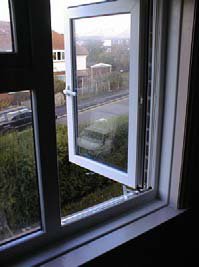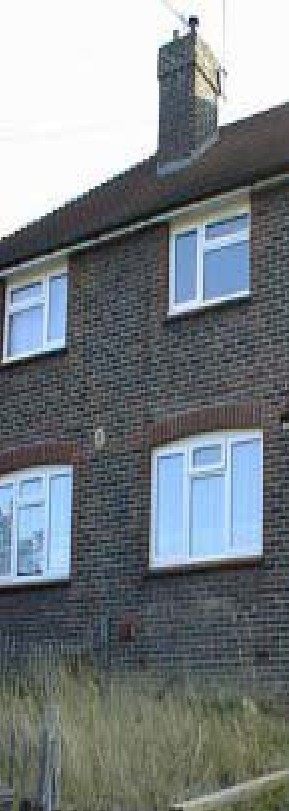


LIKELIHOOD
A
1
Type of opening light
1
a
Ease of window operation
-
b
Safety catches
3
c
Opening limiters
-
d
Sill heights
-
e
Disrepair of window
2
f
Ease of cleaning
-
g
Height of guarding
-
h
Easily climbed guarding etc
2
i
Openings in guarding
-
Key
j
Constn./ repair of guarding
-
HHSRS VERSION 2
HHSRS VERSION 2
SEPTEMBER 2004
FALLS BETWEEN LEVELS
Vulnerable group:
Persons aged under 5 years
Related hazards:
Entrapment & collision
Multiple locations
Yes
Secondary hazards
Yes
No
No
A)
First floor front bedroom window
A)
External view
A)
Full opening
iii
A)
Plan
main bedroom
b
m
f
path
i
h below
ii
grass
post & paling fence
DESCRIPTION OF HAZARD/S
Dwelling:
1930s, Semi detached house, on sloping site
A)
First floor front bedroom window:
The house has uPVC double glazed casement windows, which were
installed about 5 years ago. The window to the first floor front bedroom comprises a main fixed light below a
narrow top hung opening and a side hung opening light. This is fitted with a safety catch, which limits the opening
to less than 100 mm. However, the faulty safety catch is easily disengaged allowing the window to be opened to a
full 90 degrees. All other windows appear satisfactory.
The sill height is some 900 mm above the bedroom floor, but there is a radiator between. Externally, it is 4.2
metres above a 1 metre wide concrete path. There is a kerb and grassed area in front of this. Below, about one
metre to the side of the window, is a sagging wooden post and paling fence.
LIST OF RELEVANT MATTERS
A
2
2
-
A
2
OUTCOMES
a
Height above window/ level
b
Nature of ground/ surface #
c
Non-safety glass
# Secondary hazards
i
Concrete kerb
3 Seriously defective
2 Defective
1
Not satisfactory
-
Satisfactory/NA
Likelihood to
1 in
3,200
Outcomes to
0.5
4.6 21.5 73.4 %
As the first floor front bedroom window is the only faulty window in the dwelling,
fitting a more secure safety catch would reduce the likelihood of a fall to better
that average. Given the very small likelihood, removing the concrete path and
kerb is not really warranted, so the outcomes remain the same.
Improved
IMPROVE
Justification
NEW RATING
Av: Nos
A B C D E F G H
I
J
Average likelihood, outcomes and HHSRS score for falls between levels by persons aged
under 5 years in and around 1920-45 houses, 1997-99.
Score
5
HHSRS VERSION 2
SEPTEMBER 2004
HEALTH AND SAFETY RATING SYSTEM SCORES
1920-45 House
1 in
1800
LIKELIHOOD
Low
High
Example Average: 1564
1800
< 4200 2400 1300 750 420 240 130
75
42
24
13
7.5
4
2.5
1.5 >
Justification
OUTCOMES
Class I
Class II
Class III
Class IV
Justification
RATING
Although the sill is at a normal height, it would be possible for a child to use the radiator
to climb onto the sill and disengage the safety catch, if the window was left ajar, or for an
adult to fall while using the fully open side window to clean the fixed pane. However, with
only one such window in the house and this being in the main bedroom, the likelihood of
a fall would be no more than average for the stock - that is around 1 in 1,800
%
Average: 0.2
0.5
< 0.05 0.15 0.3
0.7
1.5
3
7
15
26
38 >
Av: 1.6
4.6
< 0.05 0.15 0.3
0.7
1.5
3
7
15
26
38 >
Av: 7.9
21.5
< 0.05 0.15 0.3
0.7
1.5
3
7
15
26
38 >
Av: 90.3
73.4
0.5
4.6
21.5
73.4
< 0.05 0.15 0.3
0.7
1.5
3
7
15
26
38 >
Depending on how the person falls, he or she will land wholly on the concrete path or
kerb, partly on the path or kerb, wholly on the grass, or on the wooden fence. The latter
is unlikely given the way the window opens. The first two possibilities appear the most
likely and, with the added height due to the sloping site, the chance of a fatal, severe or
serious fall is increased to figures above those for the average spread of harms.
Average: 4
J
A B C D E F G H
I
9
Score
RATING SCORES AFTER IMPROVEMENT